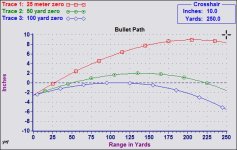It's been a lot of years for me fellas, but I seem to remember a rule of thumb for sighting in a 5.56 / AR / M16.
Is it sight in at 25 yards and it will be back on at 300 yards?
And if I remember right the bullet won't rise more than 3" in between.
This was for standard ammo, M193. Tracers were all together different I think.
Is it sight in at 25 yards and it will be back on at 300 yards?
And if I remember right the bullet won't rise more than 3" in between.
This was for standard ammo, M193. Tracers were all together different I think.

